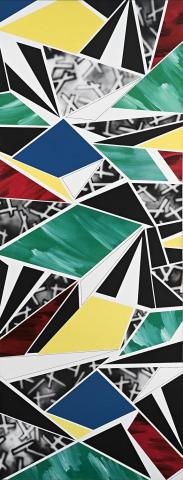50s, 1979
HOWARD ARKLEY
synthetic polymer paint on canvas
203.5 x 78.5 cm
signed, dated and inscribed with title verso: Name: Howard ARKLEY / Title 50’s / size 800 mm x 2080 mm / H Arkley 79 / Date 1979 / No. 4
Museum of Contemporary Art, Brisbane
Sotheby’s, Melbourne, 21 June 1992, lot 115
Company collection, Melbourne
Private collection, Sydney, acquired from the above in 1999
Howard Arkley: Recent Paintings, Tolarno Galleries, Melbourne, 9 – 20 May 1979, cat. 14
Howard Arkley, Coventry Gallery, Sydney, 4 – 22 March 1980, cat. 3
Australian Perspecta 1981: A Biennial Survey of Contemporary Australian Art, Art Gallery of New South Wales, Sydney, 29 May – 21 June 1981, cat. 13 (illus. in exhibition catalogue, p. 41, as ‘Untitled (Installation), 1981’)
Howard Arkley: Urban Paintings, Quentin Gallery, Perth, 7 February – 3 March 1985, cat. 12
Taylor, P., ‘Australian New Wave and the Second Degree’, Art + Text, Melbourne, 1981, no. 1, p. 28 (illus., dated as 1980)
Crawford, A., and Edgar, R., Spray: The Work of Howard Arkley, Craftsman House, Sydney, 1996, pp. 30 (illus.), 31
Gregory, J., Carnival in Suburbia. The Art of Howard Arkley, Cambridge University Press, Melbourne, 2006, fig.2.2, pp. 54 (illus.), 55 (illus. in installation shot)
Fitzpatrick, A., and Lynn, V., Howard Arkley and Friends, Tarrawarra Museum of Art, Victoria, 2015, p. 14
Arkley Works electronic catalogue raisonné reference: http://arkleyworks.com/?p=875
1968 – 1988 Selected Works, Roslyn Oxley9 Gallery, Sydney, 6 – 30 January 1988, cat. 5 (illus. in exhibition catalogue)
Suburbanism, George Paton Gallery, University of Melbourne, Melbourne, 9 August – 1 September 1988, cat. 4 (illus. in exhibition catalogue, pp. 3 – 4)
HA: Howard Arkley, Monash University Gallery, Melbourne, 18 October – 30 November 1991, cat.19
With the astronomical success of Howard Arkley’s paintings of suburban locales, it may come as a jolt to be reminded of the fact that he was just as potent and powerful as an early abstractionist. And yet despite the disparate extremes of imagery, a striking work such as 50s, 1979 shares a great deal in common with his later, more figurative works both visually and philosophically.
Arkley was obsessed with capturing his immediate environs, no matter how mundane his apparent source material. But that was Arkley, a master of making magic of the mundane and here his essential source was as basic as the decorative pattern on a beach bag spied in a Chapel Street op shop. 50s captures numerous tropes of the artists’ oeuvre – his fascination with nostalgia, his obsession with the divide between high and low culture, and his essentially academic interest in the history of contemporary art – all of which collide in this work. The 1950s was the period of the birth of American Abstraction and, soon to follow, Pop Art, and there are inklings of both elements here – what could be more Pop than sourcing imagery from a beach bag to present as a work of fine art? And, painted in 1979, Arkley’s 50s held the residue of the impact of abstraction on Australian artists captured by The Field exhibition at the National Gallery of Victoria in 1968 which a youthful Arkley had seen firsthand. Arkley’s fascination with abstracted textures had been championed by the then director of Tolarno Galleries, Georges Mora, who encouraged his explorations. But ever restless, Arkley took the textures he was exploring and utilised them to add layers to works that would follow. 50s remains a remarkably significant work for this very reason – there are strong hints of the 1950s throughout in the post-war architecture of the houses he chose, in the décor of his interiors that were inspired in part by the decorations maintained by his mother.
But there was yet another layer to the impetus behind 50s. While he claimed to be inspired in part by a beach bag, he was also well aware that in turn such geometric designs had been appropriated from the striking compositions of Wyndham Lewis (1882 – 1957), one of the founders of the British Vorticist movement, a radical break with tradition founded in 1914 and which gravitated towards depicting the jagged edges of then-modern life.
While Arkley was an artist of spontaneity, he was also well-versed, as a teacher, in the twists and turns of art history. He came of age during the era of appropriation where the notion of ‘stealing’ imagery was a commonplace, but he also held a fine awareness that what was being stolen had been stolen before – it was a matter of context. Taking a slice of design from a beach accessory allowed him to explore a cornucopia of formal abstract experimentations, elements of which we see recur throughout his formidable output and which make 50s a formative work of one of Australia’s most significant artists.
DR ASHLEY CRAWFORD
